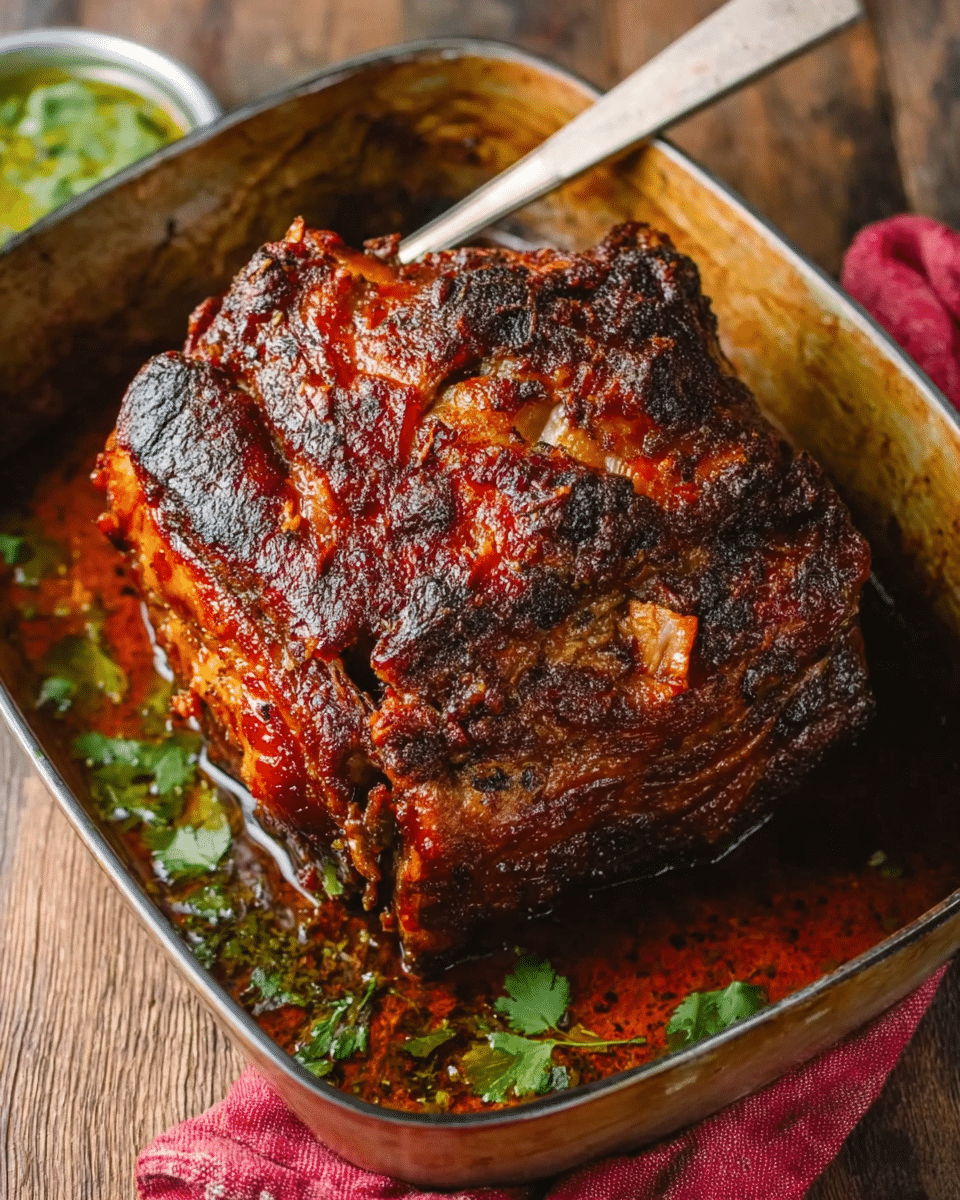Pernil is a Puerto Rican slow-roasted marinated pork shoulder, typically served around Christmastime. This version of pernil is incredibly simple to make and full of flavor, making it perfect for any time of the year. The recipe is all about the marinade, which includes garlic, vinegar, lime juice, and spices, and using a pork roast with enough fat for a crispy crust.
Full Recipe:
Ingredients
-
2 large onions (sliced)
-
6 lb boneless pork shoulder or pork butt (skin-on, optional)
-
5 cloves garlic (minced, about 2 tablespoons)
-
2 tbsp olive oil
-
1½ tbsp apple cider vinegar
-
1 tbsp fresh lime juice
-
1½ tbsp dried oregano
-
1 tsp onion powder
-
½ tsp ground cumin
-
1 tsp chili powder
-
1½ tsp sugar
-
1½ tbsp salt
-
1 tsp freshly ground black pepper
-
Water
Directions
-
Prepare the Marinade:
In a bowl, combine garlic, olive oil, vinegar, lime juice, oregano, onion powder, cumin, chili powder, sugar, salt, and black pepper. -
Marinate the Pork:
Rub the marinade all over the pork. If using a boneless roast, make sure to work the marinade into the cavity. If using skin-on pork, score the skin with a sharp knife in a cross-hatch pattern. Cover the roast with plastic wrap and refrigerate overnight (for at least 18 hours). -
Roast the Pork:
Preheat the oven to 425°F (220°C). Place the marinated pork on top of sliced onions in a large roasting pan. Add 1 cup of water to the pan. Roast for 30 minutes, rotate the pan 180°, and roast for another 30 minutes. Lower the temperature to 350°F (170°C) and roast for 2-3 hours, adding ½ cup of water every half hour. -
Finish and Serve:
Once the roast is browned and tender, tent it with aluminum foil and let it rest for 15 minutes. Slice the pork and serve with the pan juices, rice, and beans.
Nutrients (Per serving)
-
Calories: 324 kcal
-
Carbohydrates: 4g
-
Protein: 52g
-
Fat: 10g
-
Saturated Fat: 3g
-
Cholesterol: 136mg
-
Sodium: 999mg
-
Potassium: 900mg
-
Fiber: 1g
-
Sugar: 1g
This pernil roast pork is perfect for family dinners and celebrations, offering a tender, flavorful, and juicy dish that’s sure to impress!
The History and Significance of Pernil in Puerto Rican Culture
Pernil has deep cultural roots in Puerto Rico, where it is often served at Christmas celebrations and family gatherings. This dish is part of the island’s larger culinary tradition, which is a mix of Spanish, African, and indigenous Taíno influences. The use of pork as a central ingredient dates back centuries, as pigs were introduced to the Caribbean by European settlers, and the practice of roasting large cuts of pork became ingrained in local traditions.
While Pernil is most commonly associated with Christmas in Puerto Rican households, it is also a popular dish for other significant events such as birthdays, weddings, and family reunions. The act of preparing and roasting the pork is often seen as a communal activity, where family members come together to share not only the meal but also the joy of celebrating their heritage. Over time, the dish has become a symbol of Puerto Rican hospitality and culture, with each family adding their own special touch to the marinade and roasting method.
The Essential Marinade: A Flavorful Base
The marinade is the heart of this Pernil recipe. It’s a combination of garlic, olive oil, apple cider vinegar, lime juice, dried oregano, onion powder, cumin, chili powder, sugar, salt, and freshly ground black pepper. Each of these ingredients plays a crucial role in developing the bold, savory flavor profile that defines Pernil.
-
Garlic is the cornerstone of the marinade, providing a pungent, aromatic base that infuses the pork.
-
Vinegar and lime juice add acidity to the dish, which balances the richness of the pork and enhances the other flavors.
-
Dried oregano and onion powder offer depth and earthiness, giving the marinade a rustic, herbal quality that complements the pork.
-
Cumin and chili powder bring warmth and smokiness, adding an extra layer of complexity to the dish.
-
Sugar helps to balance the acidity while aiding in the caramelization of the crust during roasting.
Together, these ingredients create a marinade that penetrates the pork, making it tender, flavorful, and juicy. The longer the pork marinates (ideally overnight), the more pronounced the flavors will become, resulting in a roast that is both savory and aromatic.
Marinating the Pork: The Key to Tenderness
Once the marinade is prepared, it’s time to coat the pork with the mixture. If using a boneless pork shoulder, make sure to work the marinade into the cavity for maximum flavor infusion. If using skin-on pork, scoring the skin with a sharp knife in a cross-hatch pattern allows the marinade to penetrate deeper and helps achieve that coveted crispy, flavorful crust.
After the pork is thoroughly coated with the marinade, it’s essential to let it rest in the refrigerator for at least 18 hours, or overnight. This marinating period ensures that the flavors meld together and infuse the meat, making the roast exceptionally flavorful and tender. The longer the pork marinates, the better it will taste, so don’t rush this crucial step.
Roasting the Pork: Low and Slow for the Best Results
The beauty of Pernil lies in its slow-roasting process. Once the pork is properly marinated, it’s ready for roasting. The oven should be preheated to 425°F (220°C) for the initial 30 minutes of cooking, allowing the roast to develop a beautiful golden-brown crust. After 30 minutes, the pan is rotated 180° for even cooking, and the temperature is lowered to 350°F (170°C) for the remaining 2-3 hours. During this time, the pork should be basted with pan juices every 30 minutes to keep it moist and flavorful.
Adding water to the pan ensures that the roast stays juicy throughout the long cooking process. It also helps to create the perfect amount of steam, which helps to tenderize the pork while allowing the skin to crisp up. The key to a perfect Pernil is patience—slow-roasting allows the fat to render and the meat to become incredibly tender, while the skin crisps up into a golden, crispy crust that contrasts beautifully with the tender meat inside.
Resting the Roast: Locking in the Juices
Once the Pernil is finished roasting and the meat is browned and tender, it’s important to let it rest for about 15 minutes before slicing. Tent the roast with aluminum foil to allow the juices to redistribute throughout the meat, ensuring that every bite is juicy and flavorful.
After resting, the pork can be sliced or shredded, depending on your preference. The pan juices can be drizzled over the pork for added flavor, enhancing the richness of the dish. Pernil is often served with traditional sides like rice and beans, which complement the savory, rich flavors of the roast.
Serving Pernil: A Feast for the Senses
Pernil is typically served as the centerpiece of a large family meal, often accompanied by sides such as arroz con gandules (rice with pigeon peas), tostones (fried green plantains), and a simple green salad. The tender, juicy pork pairs perfectly with the starchy rice and the crispy, slightly sweet tostones, creating a balanced and satisfying meal.
Whether it’s served for a special occasion or as a comforting weeknight dinner, Pernil is a dish that always leaves a lasting impression. The crispy, flavorful crust, combined with the tender meat and rich marinade, makes each bite a true delight.
Conclusion
Pernil is a dish that brings people together, offering a rich and flavorful taste of Puerto Rican cuisine. This simple yet delicious recipe showcases the importance of marinating the pork and slow-roasting it to achieve a tender, juicy interior with a crispy, flavorful crust. The marinade, made with garlic, vinegar, lime juice, and a blend of spices, is the key to the deep, savory flavor that defines Pernil. Whether you’re preparing it for a holiday celebration or a family meal, Pernil is sure to impress with its bold flavors and tender texture. This dish is a true celebration of Puerto Rican culinary traditions and a meal that will bring joy to any table.






